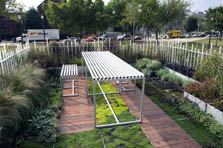

Team RISD's roof garden made for lovely outdoor dining on the National Mall with a spectacular view of many of the nation's treasured landmarks.
(Credit: Chris Gunn, Solar Decathlon)
Solar Decathlon 2005
The Green Roof: Thinking Outside the Garden
As average homeowners, we don't generally think much about our roof unless it leaks. But actually, as a large area of typically "wasted" space on a home, the roof offers yet another avenue for tapping nature's power to save energy and further sustainability goals. Enter the "green roof."
These roofs, which are typically planted with low-growing, drought-tolerant plants, serve a wide variety of "green" purposes. They offer natural insulation; conserve building energy; reduce sound pollution; cool and improve the quality of the surrounding air; and create visual appeal—including small habitats for birds and butterflies—all without taking up additional land. These roofs can also absorb and filter storm water, reducing runoff and the pollution it can carry into local waterways.
Green roofs can help mitigate the "heat-island effect," a phenomenon that raises air and surface temperatures in urban areas. Concrete and asphalt surfaces absorb and reflect the sun's energy, and the resulting hotter temperatures can speed the chemical reaction that creates low atmospheric ozone, smog's primary component. The temperatures in many cities and suburbs are up to 10°F higher than in surrounding areas with natural land cover. Adding moisture-transpiring vegetation allows the cooler air stemming from the plants to replace the hot air radiating from the hard surfaces.
Green roofs, which can be either "intensive" or "extensive," are assembled in layers, generally with plywood, insulation, rubberized material, a root barrier, a waterproofing layer, plastic for water retention, and a gravel/organic soil blend. Intensive roofs typically have 12-60 inches of soil and add significant weight to a structure, but can support shrubs and trees. These roofs are more likely to be used in commercial applications, where they can double as a public nature spot. In contrast, extensive green roofs have 3-6 inches of soil and add much less weight, features more suitable for a dwelling. Extensive green roofs can be planted with ground covers and other shallow-rooted plants, such as sedum, hen and chicks, creeping thyme, allium, phloxes, pussytoes, sea pinks, and rock cress.
For the Solar Decathlon, the student teams from The University of Texas at Austin and the Universidad Politécnica de Madrid both incorporated green roofs into their homes. The north side of the Texas home is planted with native grasses that the students envision blowing in the wind, mimicking their local grasslands. And the Madrid team designed its house with an interior courtyard, greenhouses on the south wall, and a green roof. The result is a pleasant indoor-outdoor interaction that relies heavily on plants.
The connection between plants and people is as old as time itself, and green roofs have been built in some incarnation for many years. Along with their use in the competition, there are indications that the concept is catching on. A Web search for "green roof" returned more than 500,000 hits. A Center for Green Roof Research has been established at Pennsylvania State University. Experts from Michigan State University (MSU) report that the highest density of green roofs occurs in Germany, widely considered a leader in green roof research, technology and usage, where an estimated 10% of all flat roofs are green. MSU's Green Roof Research Program was initiated in collaboration with Ford Motor Company in an effort to advise the company on the installation of a 450,000-square-foot (42,000-square-meter) green roof on an assembly plant in Dearborn, Michigan. The largest green roof worldwide is the financial district "Banco de Santander" near Madrid, Spain, where plantings and gardens are installed on more than one million square feet (93,000 square meters).
